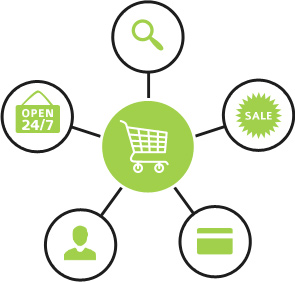
4 Easy Steps to Start a Successful Ecommerce Business
Starting a successful e-commerce business can seem daunting. However, with the right approach, it becomes much more manageable. By following these four easy steps, you can set up a thriving online store and begin your journey towards business success. In this blog post, we’ll explore these steps in detail to help you start a successful Ecommerce business.
1. Choose Your Niche
Identify Your Market
Choosing a niche is the first and crucial step in starting a successful e-commerce business. Identify a market that interests you and has demand. For instance, if you’re passionate about fitness, consider selling fitness gear or supplements.
Research Competitors
Once you have a niche in mind, research your competitors. Analyze their strengths and weaknesses. This research helps you understand what works and what doesn’t. Moreover, it reveals opportunities for differentiation.
Define Your Target Audience
Understanding your target audience is essential. Determine their preferences, needs, and buying behaviors. Tailor your product offerings and marketing strategies to meet their expectations. A well-defined target audience will help you create effective campaigns and drive sales.
2. Set Up Your Online Store
Choose the Right E-Commerce Platform
Selecting the right e-commerce platform is key to starting a successful e-commerce business. Platforms like Shopify, WooCommerce, and Magento offer various features. Evaluate each based on your needs, budget, and technical skills.
Design an Attractive Store
Your online store’s design should be user-friendly and visually appealing. Use high-quality images and clear descriptions for your products. Ensure easy navigation and a smooth checkout process. An attractive and functional store enhances user experience and encourages sales.
Secure Your Website
Security is vital for any e-commerce business. Implement SSL certificates to protect customer data. Additionally, use secure payment gateways to process transactions safely. A secure website builds trust and ensures a safe shopping experience for your customers.
3. Develop a Marketing Strategy
Create a Content Plan
A well-crafted content plan is essential for attracting and engaging customers. Develop blog posts, social media content, and email newsletters that resonate with your audience. For example, if you sell beauty products, create content about skincare tips or product reviews.
Leverage Social Media
Social media platforms are powerful tools for promoting your e-commerce business. Create engaging posts and run targeted ads to reach potential customers. Platforms like Instagram, Facebook, and Pinterest can drive traffic to your store and boost brand awareness.
Optimize for Search Engines
Search engine optimization (SEO) is crucial for visibility. Use relevant keywords in your product descriptions, titles, and meta tags. Additionally, focus on creating valuable content that attracts organic traffic. SEO helps your store rank higher in search results, increasing your chances of attracting customers.
4. Monitor and Improve
Track Performance Metrics
Monitoring your e-commerce business’s performance is essential for success. Use analytics tools to track metrics like website traffic, conversion rates, and average order value. These insights help you understand what’s working and what needs improvement.
Gather Customer Feedback
Customer feedback provides valuable insights into your business. Encourage customers to leave reviews and share their experiences. Use this feedback to make necessary adjustments and improve your products and services. Satisfied customers are more likely to return and recommend your store to others.
Continuously Optimize Your Store
Optimization is an ongoing process. Regularly update your website’s design, product listings, and marketing strategies. Test different approaches to see what resonates best with your audience. By continuously optimizing your store, you ensure that it remains relevant and competitive.
Conclusion
Starting a successful e-commerce business involves several key steps. First, choose a niche that interests you and has market demand. Next, set up your online store with the right platform and design. Then, develop a robust marketing strategy to attract and engage customers. Finally, monitor your performance, gather feedback, and continuously optimize your store.
By following these four easy steps, you can build a solid foundation for your e-commerce business. Each step is crucial for ensuring long-term success and achieving your business goals. Start implementing these strategies today and pave the way for a prosperous online store.
